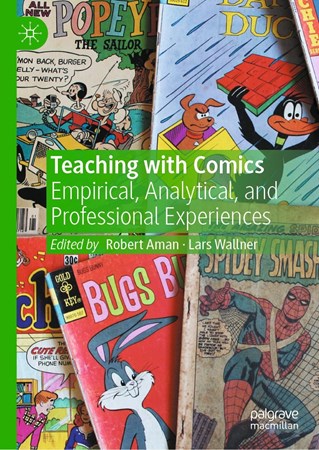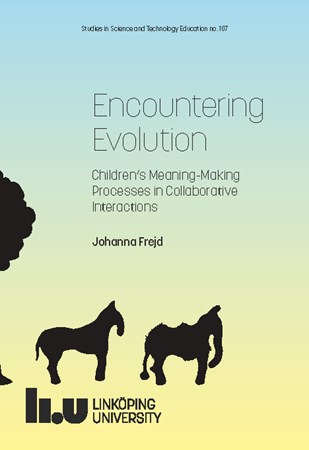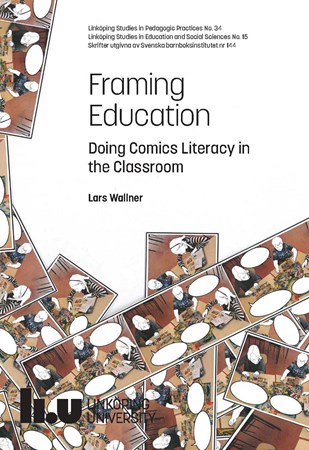Since 2022, education on evolution and biodiversity have been included in science education for grades 4–6. Since it is new content for many teachers, there is a need for new teaching tools for this group of students. We have, together with a professional illustrator, produced a comic book, Cats on the Run, in 2022-2023, to meet this need. The comic book is based on research on science education, research on comics in teaching and subject research on evolution. The plot is that two kittens fall into a magical portal that takes them to a place between time and space where they are drawn into a problem regarding the threat to biodiversity. The idea of the story came from an eleven-year-old, a good representative of the target group for the study. The purpose of the research project is to investigate, together with teachers, how a produced comic book can be used in the staging of teaching about evolution and what function the comic material has in students' meaning-making about evolution. The goal is to develop knowledge about the use of comics material in science education.
The following scientific questions guide the project:
- How do students and teachers interact with the comic material?
- What evolutionary processes are expressed in teaching where the comic material is used?
- What is the function of the comic material in teachers' and pupils' meaning making about evolution?
Teaching Evolution Through Stories
The key evolutionary concepts discussed in Cats on the Run (variety, heredity, and natural selection) are complex and often misunderstood by students aged 5-12, as well as by university students and adults. At the same time, several studies show that there are good conditions for children to understand the basics of evolutionary processes if they are exposed to the subject in age-appropriate activities. Something that has proven to be important is that children in education have access to materials, such as pictures, that they can use as multimodal resources in meaning-making and in conversations with each other and with teachers. In this study, we have chosen to use a comic book as a multimodal medium, which combines forms of expression such as image and writing and where the images also show movements and sound effects. The series' sequential storytelling and combination of different modalities can facilitate both students' understanding of the story itself and their understanding of the scientific processes it focuses on (see, for example, Scott McCloud’s book Understanding Comics from 1993).
Comics in teaching
Comic
s are a narrative sequential organization of image and (usually) words. The strength of comic storytelling lies, above all, in combining multiple modalities to create impressions and effects that a single modality (e.g., just written words) could not. One argument for using fictional stories in the form of comics in teaching is that the form itself differs from the texts that students usually encounter in school. Therefore, the comic book may appeal to students who have negative perceptions of traditional textual schoolwork. What's more, character-driven stories are engaging— thus, this project's comic book focuses on the adventures of two kittens. Comics' combination of written words and images can also motivate students who prefer one or the other, while studies show that teens who do not identify as "scientists" find comics accessible and engaging. However, comics are not a one-size-fits-all solution. It is not self-evident that all pupils appreciate comics or feel that comics contribute to the learning of a specific subject content. For example, in his article “Kid Friendly? Constructions of Comics Literacy in the Classroom” (2022, in the journal Language and Literature, no. 29) Wallner shows how discourses around comic books as literature aimed at children can contribute to students' and teachers' perceptions of the medium and its content. For example, some pupils may perceive comics as childish, and contrary to the school discourse that text is the 'more adult' medium. In this way, the series form can be both positive and negative for motivation to learn. For these reasons, it is interesting to investigate how the use of comics can facilitate, but also complicate, meaning making about scientific processes.
Through this project, participating students and teachers can gain in-depth knowledge of evolutionary processes. In the long term, we can also gain broader knowledge about how popular cultural expressions can be used as teaching resources in science education in the younger grades of primary school, and how comics can be used as a resource in teaching about evolution.
Implementation
We intend, together with teachers, to investigate how a produced comic book can be used in the staging of teaching about evolution and what function the comic material has in students' meaning making about evolution. In the planning together with the teachers, we intend to use the model for learning design sequences (see, e.g., Björklund Boistrup & Selander’s book, Designs for Research, Teaching and Learning, 2022). For the comic book, we have produced a teacher's guide with suggestions for activities that the classes can work with, but have not planned the content in detail. Instead, both content and various activities that are used to achieve the goal of the teaching are developed in close collaboration with the teachers. Depending on the local conditions in the classroom, the group of children, and the teacher's influence, the teaching will thus be shaped and reshaped in interaction with the material.
During the 2024–2025 school year, we will, together with the teachers, with the support of the LDS model, plan the teaching in two classes and then follow the teaching with participatory video observations. Video data is collected with 360 cameras that are placed in the classroom and supplemented with audio recording. The video observations add aspects of how students and teachers interact with the material and which evolutionary processes are focused on and expressed in the teaching. In this way, it enables us to study the interaction in detail and look at the material repeatedly to capture, for example, gazes, gestures, and the like, which are important for the intersubjective understanding between participants. We will also collect student representations (e.g., assessed assignments, pictures, etc.) as these also contribute with information about students' meaning making. This project provides new important insights into how work on evolution can be done and on how teachers and students reason about different aspects of the new subject and about teaching where comics are used as a learning resource.






